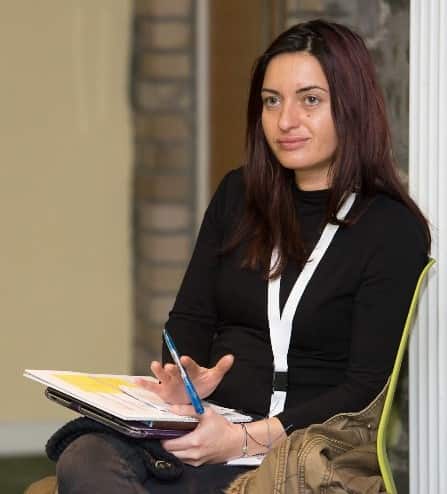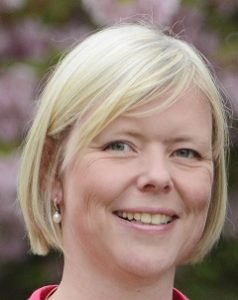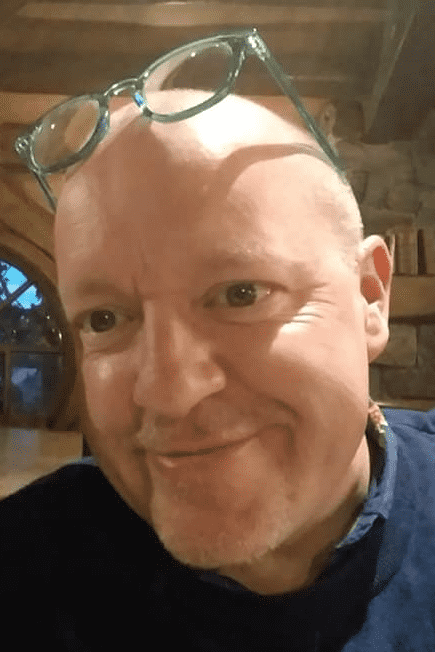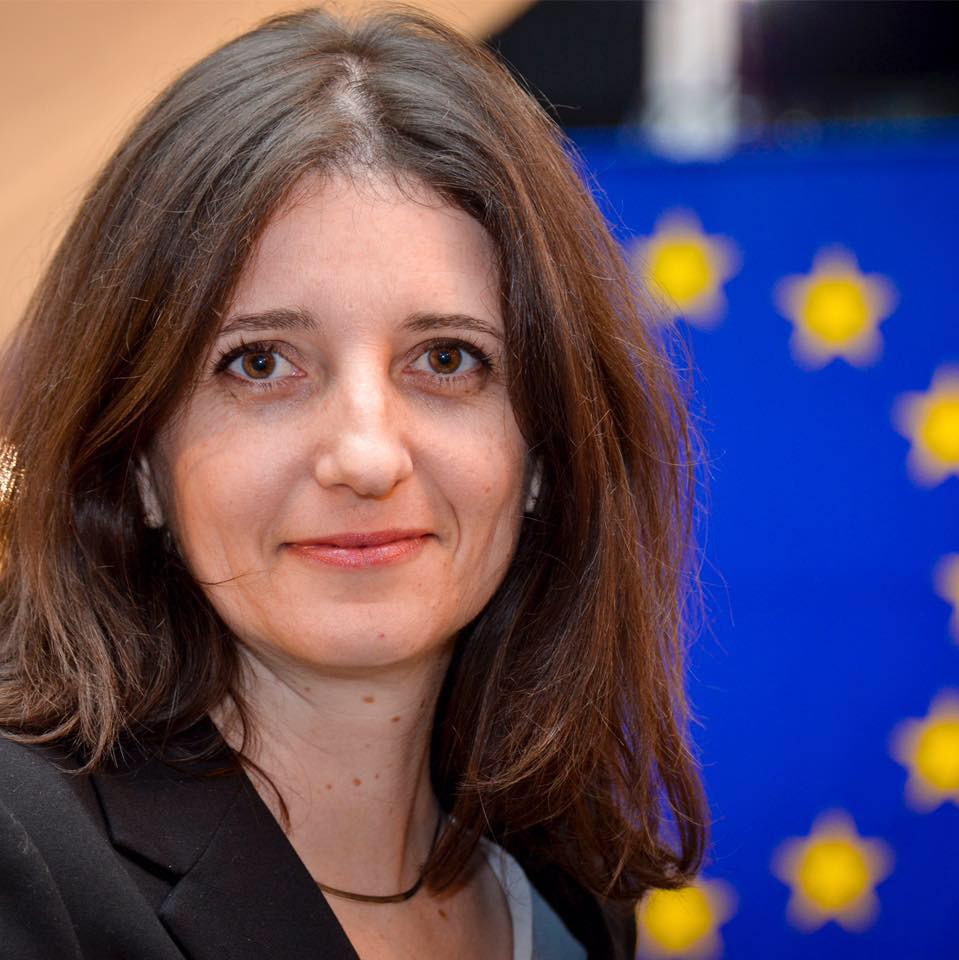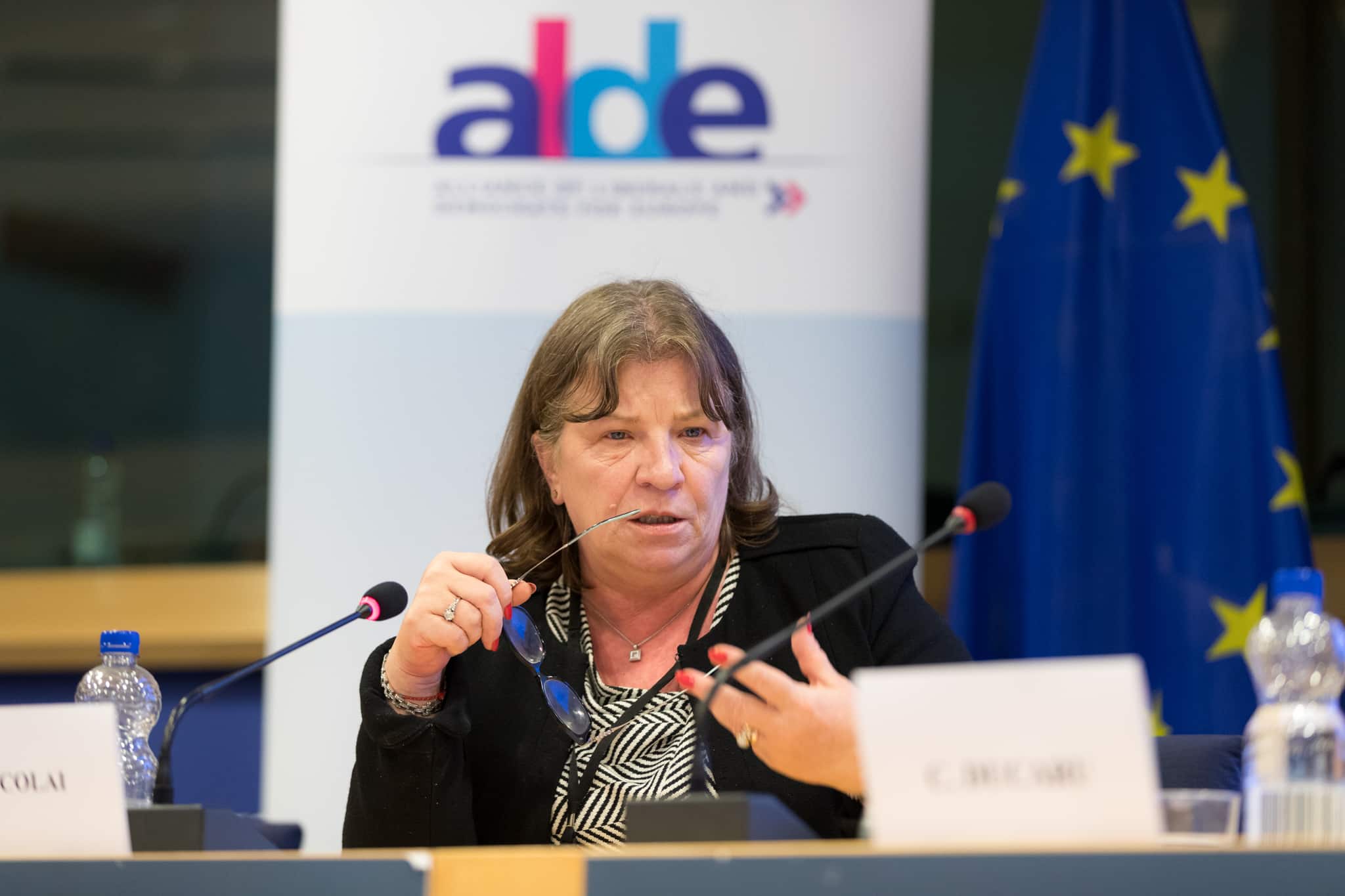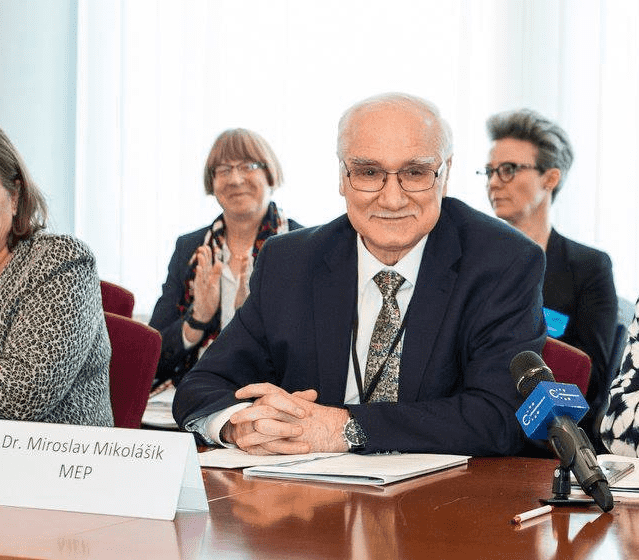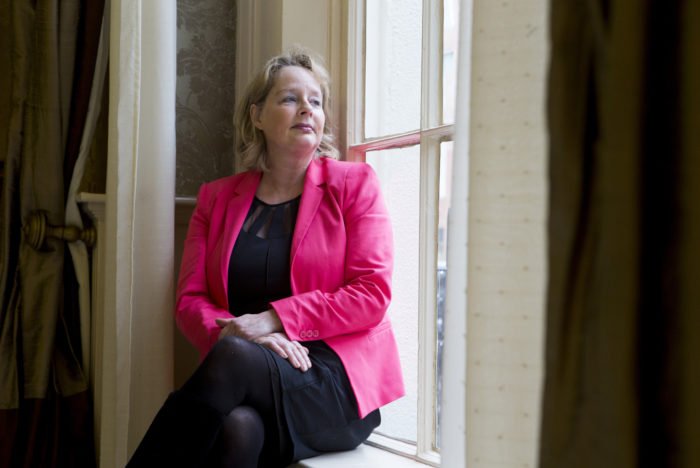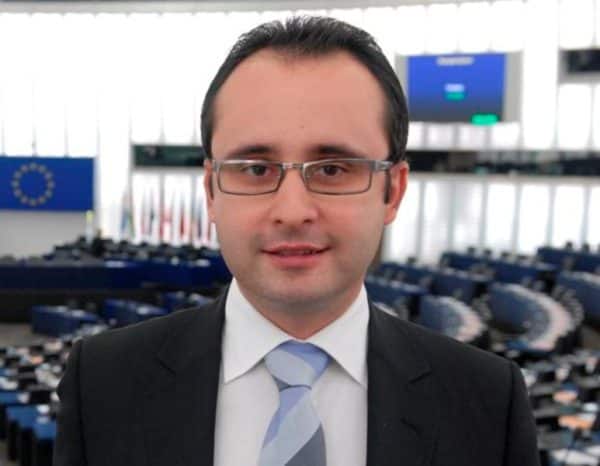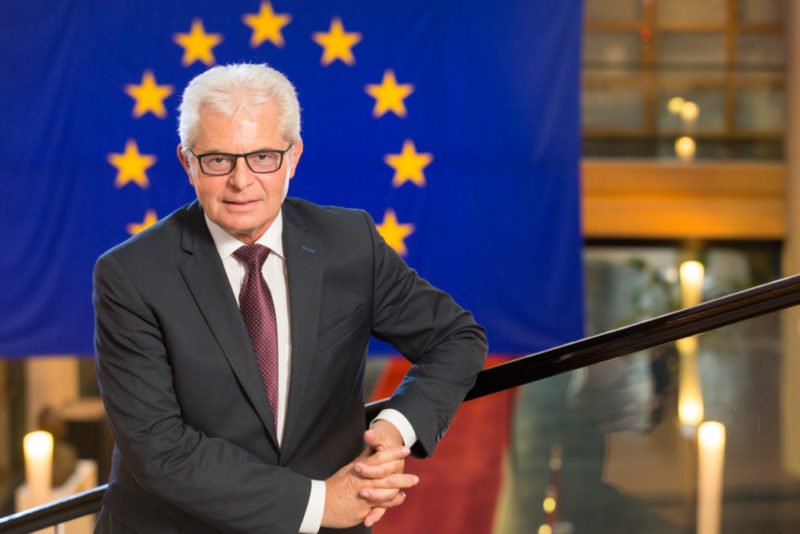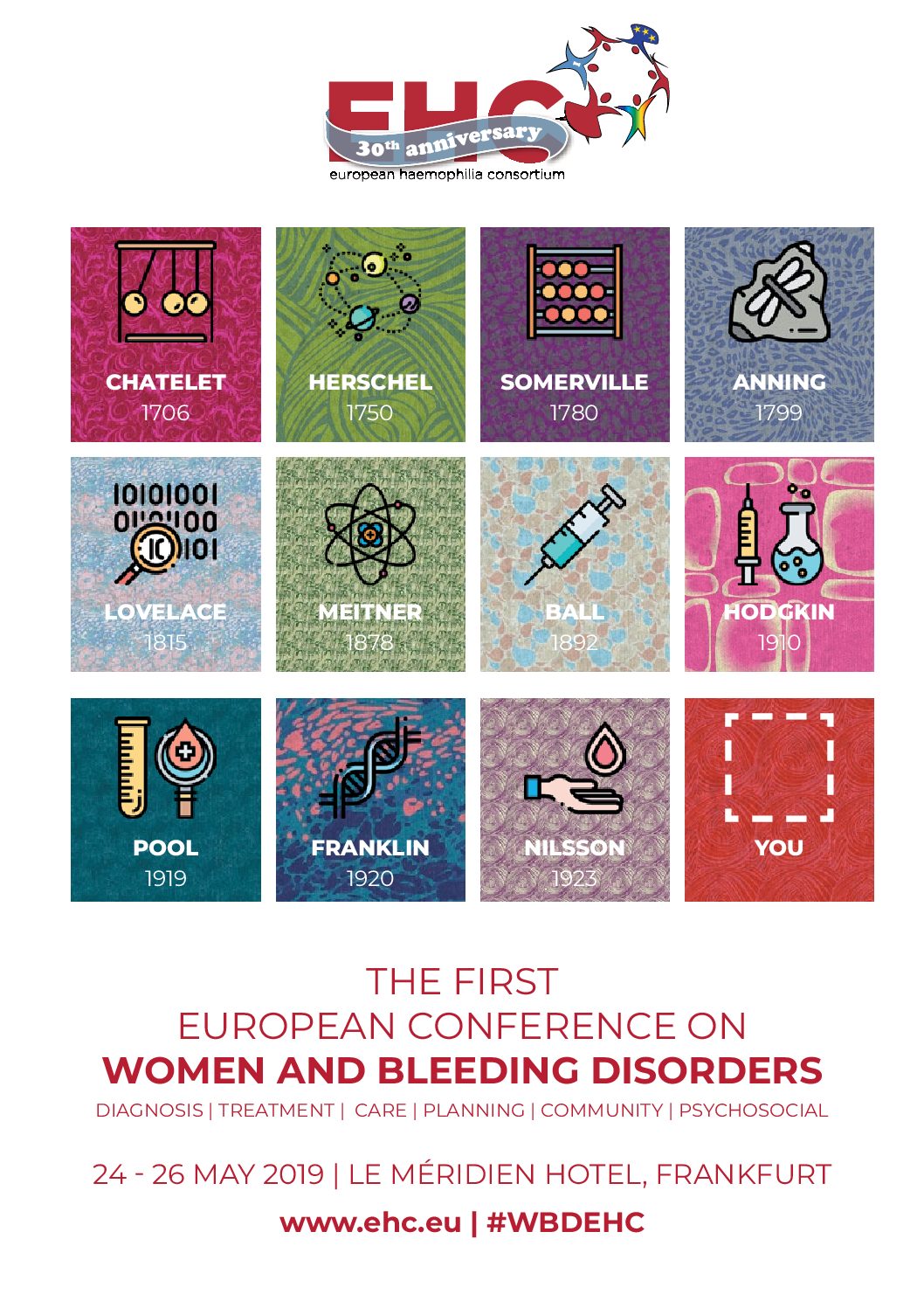
It was an idea that was long overdue: a conference, discussion and information-sharing platform for women with bleeding disorders. Abounding with misconceptions, general disregard and a lack of information, women with bleeding disorders have been sadly ignored and underrepresented in our communities. The First European Women and Bleeding Disorders (WBD) Conference, May 24-26, 2019 in Frankfurt, Germany, was an unqualified success. With over 30 countries, including representatives from the United States and Canada and partner organisations World Federation of Hemophilia (WFH) and National Hemophilia Foundation (NHF), the event went far beyond European borders. EHC CEO Amanda Bok opened the conference, establishing a safe and dynamic space for all participants. Prior to the event, Ms. Bok said, “When we conceived the WBD conference, we took a leap of faith. Build it and they will come, we thought. Now it’s here, and there is palpable excitement. For participants, it is finally something about them, something many of them thought would never happen.”
Day One
Naja Skouw-Rasmussen, Member of the EHC Steering Committee and Chair of the EHC WBD Committee, presented Women and bleeding disorder in Europe: Results from EHC Survey about women and bleeding disorders in Europe. The survey had a high response rate of 709 responses from 27 of the 46 EHC National Member Organisations (NMO) members, and 15 responses from medical professionals. The survey was translated into numerous languages, including Russian, Dutch, French, Danish and Latvian. Questions included such topics as physical activity, active life, romantic and social life, and reproductive life. Alarmingly, between 40 to 70% of different groups, regardless of the severity of disorder, reported my bleeding disorder impacts my desire or ability to have children. Without a doubt, menstruation is the primary concern of participants, including how to talk about it, how to bring menstruation into the public arena without shame and how to help other women. It is almost inconceivable to many that women with bleeding disorders my endure needing to change their pads 40 times a day, or needing blood transfusions to get through a period, and this happens 12 times a year or more. The presentation included an overview of the status of treatment and the work and progress of NMOs. Education and frank discussion about treatment and understanding women’s issues must involve a massive rethink about how we discuss and think about menstruation. Ms. Skouw-Rasmussen succinctly but perfectly said, “We need to talk about it like every other bleed in our community.”
Dr. Michelle Lavin, Clinical Lead for coagulation haematology research at the Irish Centre for Vascular Biology at the Royal College of Surgeons in Ireland, presented the enlightening but alarming Overview of rare bleeding disorders in women. The main perception in nearly all societies is that bleeding disorders are a male issue. Where is the primary diagnosis point for women? Treatment centers or gynecologists? Dr. Lavin presented shocking statistics of the current situation of women with bleeding disorders in Europe. Bleeding disorders of varying severity may affect as many as 4.5 million women in Europe. Of those numbers, the numbers of women being diagnosed is very low or even non-existent in some places. As Dr. Lavin pointed out, every patient with haemophilia has a mother. They are certainly not being picked up or detected. Dr. Lavin said, ”Diagnosis of von Willebrand disease in women (the most common bleeding disorder in women) is appalling.” Dr. Lavin reinforced that, while diagnosis is relatively higher in some countries (85% in the Netherlands and 605 in Ireland), there is still incredible squeamishness about talking about menstruation. Dr. Lavin said we need to link websites and to create culturally-appropriate content. Last, and this may be true for nearly all patient organisations: patients should not only be involved in the data collection process of a survey but in the design of the survey. Dr. Lavin led an engaging question and answer session. Dr. Alison Dougall, Assistant Professor Dublin Dental University Hospital, reminded participants that the second primary sign of a bleeding disorders is gum bleeding. Unless women are alerted and specifically asked, this condition is often ignored. Dr. Dougall said, “Healthy gums don’t bleed. We should be asking “how long gums bleed after brushing teeth” as a sign of a bleeding disorder.”
Dr. Eugenia Biguzzi, Haematologist at the Centro Emofilia e Trombosi A. Bianchi Bonomi in Milan followed with Haemophilia – inheritance and carrier detection and RBD – transmission, inheritance and detection. Dr. Biguzzi gave an informative presentation using the royal houses of Europe to illustrate and define bleeding disorders. The father will transmit the Y chromosome to sons without effect but the daughters will receive the X chromosome and be a carrier. The mother will transmit the chromosome to the son guaranteeing the condition, and with a 50% chance of transmission to a daughter. Why are there sporadic cases of haemophilia? Because gene mutations occur spontaneously and frequently. Everyone probably has mutations in any given gene. Genetic counseling involves obstetric/gynecologists, haematologists and clinical genetics experts. The aims of genetic counseling are to inform a couple of their genetic risk, present care and treatment as well as reproductive options, and explain subsequent choices if the fetus is affected. Genetic counseling is preferable in pre-conception but in reality, usually happens after conception. Dr. Biguzzi presented an innovative way to understand DNA mutations through sentence patterning.
Dr. Karin van Galen, UMC Utrecht, spoke about von Willebrand disease (VWD) – transmission, inheritance and detection. How do we detect VWD? This is done through examination of bleeding history and laboratory assessment. Dr. van Galen’s discussion included the pros (may help in subtyping, congenital vs. acquired) versus the cons (not diagnostic) of genetic testing. Dr. Razin Kadir, consultant obstetrician and gynaecologist at the Royal Free London hospital NHDS Foundation Trust, spoke about the importance and difficulties of Prenatal diagnosis (PND) and testing and the difficulties of reproductive choice and decision making, especially in reference to different cultural and religious considerations. Dr. Kadir discussed results of a PND survey and the revealing number that, in carriers considering their reproductive choices, over 50% decided not to have a child or more children. This number was borne out in EHC’s survey. A quarter of patients terminated pregnancy. Additionally, the original PND method is invasive and sometimes risky resulting in fetal loss. Just over 20% of carriers of haemophilia used the procedure, versus over 70% with Down’s syndrome. Yet there is hope. There is also a non-invasive PND procedure: free fetal DNA in maternal plasma (detection of Y-chromosome-specific sequence (SRY)). This technique resulted in a dramatic overall uptake of PND. The question and answer discussion involved active participation discussing real-life experiences and the reality of most situations involving WBD and their reproductive choices, PND and child birth. Dr. Kadir said, “When we compare how long it has taken us to get this First Conference on Women and Bleeding Disorders, we still have a long way to go and must do our best.” There was also discussion about the General Data Protection Regulation (GDPR), which has had a negative impact on access to information. Privacy rights sometimes do not allow for a greater sharing of information.
The World Federation of Hemophilia (WFH)’s Luisa Durante’s Raising awareness globally for women with inherited bleeding disorders provided real-life experience of WBD initiatives in Honduras, Malaysia, Colombia, Botswana, Nicaragua and Bangladesh. Swedish Haemophilia Society’s Anna Tollwé, Slovakia’s NMO Vice-President MD. Martin Sedmina, Lativa Haemophilia Society President Baiba Ziemele and Slovakia’s Alexandra Vaskova presented their experiences. Dr. Sedmina discussed the NMO’s experience with WBD and its plan to create a women’s committee (does your NMO have a women’s committee?). Ms. Vaskova gave a personal experience of a WBD in our society and summer camps in Slovakia. Ms. Ziemele spoke about her experiences and difficulties in Latvia. Though small, the Latvian NMO and its website has 15,000 hits a year, proving that the demand for information and for a corresponding website and social media platform is a powerful weapon. Ms. Ziemele said, “Health is a human right, but it still took 10 years for me to receive adequate treatment.” Ms. Tollwé gave an eye-opening presentation about the creation and difficulties of the Swedish NMO’s women’s committee. Even in liberal societies there can be initial resistance to discussion and better treatment for WBD. There was an audience-grabbing video showing how many girls with bleeding disorders suffer in silence (www.blodarsjuk.nu).
Day Two
Dr. Michelle Lavin chaired a panel discussion on Preparing for menarche: Developing a treatment and management plan for heavy periods – including treatment options and how to approach and prepare for adolescence with Dr. Rezan Kadir, Dr. Roseline d’Oiron (Clinician Investigator at the Reference Centre for Haemophilia and Other Congenital Rare Bleeding Disorders, Congenital Platelets Disorders and von Willebrand disease at Bicêtre Hospital AP-HP – Paris XI University), Anna Tollwé, Debra Pollard (Lead Nurse at Royal Free London NHS Foundation Trust) and Dr. Sylvia von Mackensen (Senior Scientist, University Medical Centre Hamburg)
The discussion started with frank comments on preparing young girls and speaking openly. A key point was reminding young women that they are not the problem; they have a disease that is causing the problem. Open discussion followed about what to expect and what language to use, for example the terms contraception, which might be alarming to parents, versus hormonal treatment to make lives better and reduce bleedings. Speakers discussed possible tools (e.g. the pill) and that one solution does not fit everyone. Panelists also discussed potential counter benefits, like hormonal difficulties and additional bleeding. The discussion progressed to adolescents and giving appropriate information about future pregnancies. With 1/3 of carriers having low-factor levels, testing is crucial. Bleeding may be the result of polyps, for example. Changes in bleeding patterns need to be assessed and understood. Outcomes of patient assessments may take up to two years, which may be a financial and time drain on patients. Dr. Lavin stressed, “We need standardisation of data collection.” Dr. Lavin then brought up the design of such data collection. Patient panelists underscored that both males and females with VWD face recognition problems. Dr. Lavin affirmed the importance of information and said, “Haemostasis is not just haemophilia.” It was suggested haemophilia treatment centres might be renamed haemostasis treatment centers. Ill-health is not just physical. Heavy menstrual bleeding is also a quality of life issue. Dr. Lavin brought up the ridiculousness of making female athletes wear white and the psychosocial effects of such behavior. Doctors stressing possible solutions, NMO support and breaking taboos are essential. Ms. Pollard said, “The impact of heavy menstrual bleeding (HMB) can be extremely isolating.” The question and answer follow-up led to discussions about menopause and the stigma of early loss of menstrual cycles. Treatment centres and NMOs should and must have open access and healthcare professionals should be working in unison.
Other gynaecological issues in WBD was hosted by the Netherlands’ Evelyn Grimberg and Portugal’s Ana Pastor. Dr. Angelika Bartorova, Medical Director of the National Haemophilia Centre and Haemostasis and Thrombosis Unit of the Department of Haematology and Transfusion Medicine, University Hospital, Bratislava, presented extensive scientific discussion about bleeding in surgery, including treatment options for Rare Bleeding Disorders (RBD) and the do’s and don’ts for surgery. Dr. van Galen presented case studies, focusing on mid-cycle pain, possible hormonal ovulation suppression and timely treatment with clotting factor correction in cases where patients desire pregnancy. Dr. Mackensen discussed the impact of bleeding disorders on women’s health-related quality of life (HRQoL). Psychosocial programmes should be created, expanded and supported. Dr. Ioannis Tsimpanakos, consultant in obstetrics and gynaecology from the Royal Free London NHS Foundation Trust, presented Management of pelvic pain in women with bleeding disorders, discussing chronic vs. acute pain, and non-hormonal pharmacological management. Dr. Tsimpanakos said, “We need to educate doctors.” Ms. Grimberg presented experiences about preparing for surgery. Almost given painkillers with blood thinners, Evelyn learned and expressed that preparing yourself is crucial.
Two breakout sessions followed: Fertility and pregnancy in bleeding disorders with moderators Dr. Roseline d’Oiron, Dr. Rezan Kadir and Norway’s Marie Lahn Rømcke This breakout session was as open discussion in which participants were able to freely discuss any issues surrounding fertility and pregnancy in women affected by bleeding disorders. Support from your NMO and peer-to-peer support followed with moderators Evelyn Grimberg and France’s Yannick Collé: This breakout session showcased examples on how to build a peer support group and how to utilise your NMO to raise awareness about and provide support to women with bleeding disorders. There was a very useful practical exercise on how to create a women’s committee in your NMO.
EHC Steering Committee Member and AFH’s Olivia Romero-Lux chaired Non-gynaecological issues in women with bleeding disorders. The session started with Detection & management of iron deficiency and anaemia in WBDs with Dr. Biguzzi. Dr. Biguzzi stressed the importance of sharing information with the patient. Oral therapy in low doses for non-anaemic patient (better absorption), and of course a higher rate in anaemic patients, which may cause stomach issues and other unwanted side-effects. Intravenous therapy has dramatically improved (requiring fewer injections). Recommendations included eating well, listening to your body and checking haemoglobin levels. Oral care in WBD with Dr. Alison Dougall stressed that dental health is mandatory for overall holistic health. People with haemophilia are five times more likely to have gingivitis and there is nearly no data about women with bleeding disorders and dental health. Dr. Dougall led a popular session about smiling and understanding societal perceptions while also offering practical solutions.
Women and Bleeding Disorders Premiere
For many, the Saturday night screening of “Women and Bleeding Disorders” was the highlight of the conference. Directed and produced by director Goran Kapetanovic, who previously collaborated with the EHC on “Haemophilia Stories” and “Inhibitor Stories,” the film echoed the general mood of the conference. Through all the science, difficult subject matter and understandably deep emotion, a true sense of camaraderie and the feeling that something special was happening permeated Day Two.
Day Three
Sunday’s sessions started with the Impact of bleeding disorders on quality of life (QoL) with Naja Skouw-Rasmussen. After a discussion of the tools to evaluate quality of life, there was a comparison of male vs. female experience of bleeding disorders. There was an analogy comparing QoL between patients with HIV and female patients with bleeding disorders with regard to both cohort’s uncertainty about the future. Support from family and friends, your NMO and healthcare professionals (and to properly and adequately involve your healthcare professional) also has a dramatic effect on QoL. When considering QoL, Ms. Skouw-Rasmussen said, “You must consider what QoL is for you. What kind of limitations do you set for yourself because of the bleeding disorder?”
Psycho-social issues with Debra Pollard started with a heartwarming moment of praise for the conference, a feeling that was expressed over and over again by participants. Ms. Pollard expressed the reality that many mothers and families with members with bleeding disorders feel when she said, “We all want to hug our children. What happens when you pick up your baby who has a severe bleeding disorder? You are afraid you will leave a bruise. That has an immense psycho-social impact on a mother and a family.” The holistic and emotionally-realistic presentation included spiritual health and a checklist of difficult psych-social issues: being believed, fighting for care, mother’s instincts, physical health affecting mental/emotional health, sexuality and relationships, and even guilt. This was echoed by participants, many of whom stressed that the sense of guilt was one of the primary issues faced by WBD.
Two breakout sessions followed: One was on Management of labour, delivery and neonatal care with moderators Dr. Rezan Kadir and Dr. Angelika Batorova. This breakout session was an open discussion in which participants were able to freely discuss any issues related to the management of labour, delivery and neonatal care in women affected by bleeding disorders. The other session was on Support from the haemophilia treatment centre with moderators Debra Pollard and Liora Tevet (Director of Aleh, the Israalil Haemophilia Association). In this breakout session, moderators explored how to build dialogue with and ensure that women with bleeding disorders are recognised by local haemophilia treatment centres. This breakout session was an open discussion in which participants were able to freely engage with moderators and other participants.
The closing session was chaired by EHC CEO Amanda Bok. The closing panel included Dr. Rezan Kadir, Dr. Roseline d’Oiron, Debra Pollard and Naja Skouw-Rasmussen. Evaluations and feedback followed with EHC Public Policy Officer Laura Savini and Amanda Bok.
Recurring themes of the First European Women and Bleeding Disorders Conference included: having no diagnosis or under-diagnosis, the general lack of knowledge/information, and the need for much more effort by all bleeding disorder organisations, treatment centres and NMOs to ensure awareness, education and appropriate advocacy tools. If there was a primary takeaway from the conference, it was the establishment of an anthem for women with bleeding disorders: you are not alone. The sense of excitement, progress, empowerment and finally being heard and listened to was immeasurable: stronger, together. The future is looking a little bit brighter. Hungarian participant and EHC Youth Leadership alumni Karola Diosi said, “This is the place I have to be.”
Find the complete event and programme at https://www.ehc.eu/events/conference-on-women-and-bleeding-disorders/
The Conference received platinum-level sponsorship from CSL Behring and silver-level sponsorship from Novo Nordisk. Takeda contributed financially towards the “Women and Bleeding Disorders” documentary.



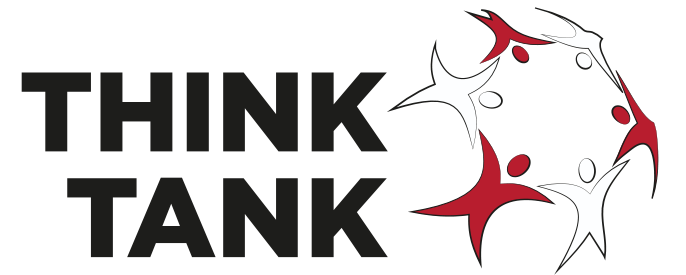
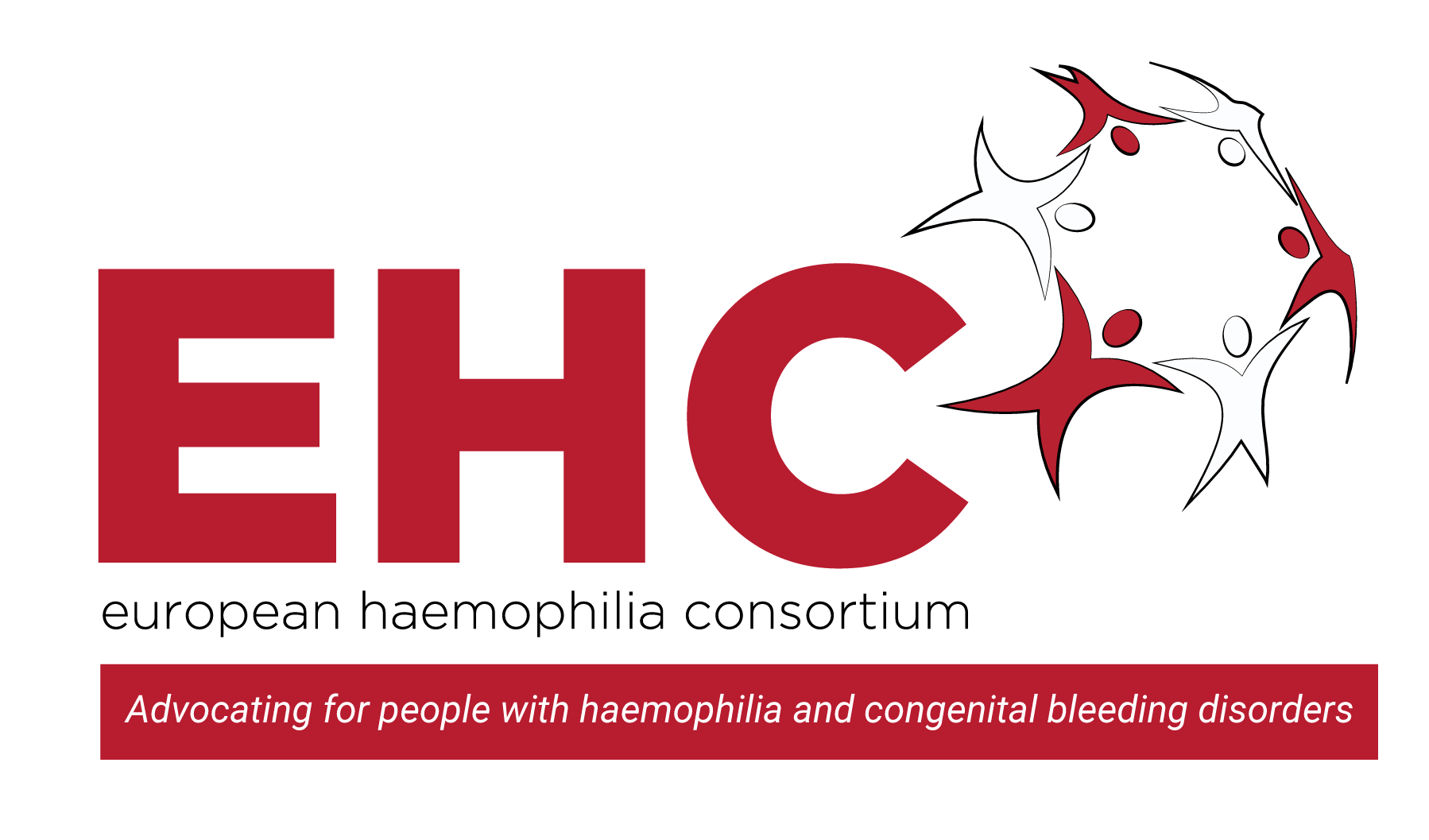
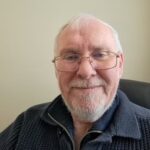 Jim is aged 66 and has Haemophilia A with a high titer inhibitor which he developed at age 14.
Jim is aged 66 and has Haemophilia A with a high titer inhibitor which he developed at age 14. Maria Elisa Mancuso (MD, PhD) is a Haematologist and works as a Senior Haematology Consultant at the Center for Thrombosis and Haemorrhagic Diseases of IRCCS Humanitas Research Hospital in Rozzano, Milan, Italy. She is Adjunct Clinical Professor at Humanitas University. She obtained a post-degree in Clinical and Experimental Haematology and a PhD in Clinical Methodology. She is involved in clinical research and has published several original articles in peer-reviewed journals a The Lancet, Blood, Journal of Thrombosis and Haemostasis, Haematologica, Thrombosis and Haemostasis, British Journal of Haematology and Haemophilia. She is reviewer for several peer-reviewed journals and member of the Editorial Board of JTH. She is a member of several scientific societies (ISTH, WFH, ASH, EAHAD, SISET, AICE) and was a medical member of the Inhibitor Working Group of the European Hemophilia Consortium. She is co-chair of the ADVANCE Study Group. She has acted also as co-chair of the Scientific and Standardization Subcommittee of ISTH on FVIII, FIX and rare bleeding disorders. She has been involved as principal and co-investigator in several clinical trials, and she takes care of both children and adults with hemophilia and other congenital bleeding disorders with a specific scientific interest in novel therapies, prophylaxis, inhibitors, and chronic hepatitis C.
Maria Elisa Mancuso (MD, PhD) is a Haematologist and works as a Senior Haematology Consultant at the Center for Thrombosis and Haemorrhagic Diseases of IRCCS Humanitas Research Hospital in Rozzano, Milan, Italy. She is Adjunct Clinical Professor at Humanitas University. She obtained a post-degree in Clinical and Experimental Haematology and a PhD in Clinical Methodology. She is involved in clinical research and has published several original articles in peer-reviewed journals a The Lancet, Blood, Journal of Thrombosis and Haemostasis, Haematologica, Thrombosis and Haemostasis, British Journal of Haematology and Haemophilia. She is reviewer for several peer-reviewed journals and member of the Editorial Board of JTH. She is a member of several scientific societies (ISTH, WFH, ASH, EAHAD, SISET, AICE) and was a medical member of the Inhibitor Working Group of the European Hemophilia Consortium. She is co-chair of the ADVANCE Study Group. She has acted also as co-chair of the Scientific and Standardization Subcommittee of ISTH on FVIII, FIX and rare bleeding disorders. She has been involved as principal and co-investigator in several clinical trials, and she takes care of both children and adults with hemophilia and other congenital bleeding disorders with a specific scientific interest in novel therapies, prophylaxis, inhibitors, and chronic hepatitis C.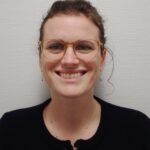 As a patient with factor II deficiency, the diagnostic and treatment of rare bleeding disorders is a matter dear to my heart. My motivation to participate in the work of the ERIN committee is to improve both diagnostic and treatment for patients with rare bleeding disorders across Europe.
As a patient with factor II deficiency, the diagnostic and treatment of rare bleeding disorders is a matter dear to my heart. My motivation to participate in the work of the ERIN committee is to improve both diagnostic and treatment for patients with rare bleeding disorders across Europe.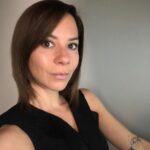 Economist and financial expert by profession, executive coach and trainer by passion and haemophilia advocate by every drop of my blood through my son (who has severe haemophilia A with inhibitors). Bringing a good decade of practical experience from the corporate insurance world, laser focus, growth mindset and resilience from my own experience, offering you anything I can just do, in hope that together we can make life more fulfilled for those impacted by bleeding disorders.
Economist and financial expert by profession, executive coach and trainer by passion and haemophilia advocate by every drop of my blood through my son (who has severe haemophilia A with inhibitors). Bringing a good decade of practical experience from the corporate insurance world, laser focus, growth mindset and resilience from my own experience, offering you anything I can just do, in hope that together we can make life more fulfilled for those impacted by bleeding disorders.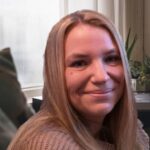 Amy Owen-Wyard is a Registered Mental Health Nurse. With experience working with children, young people, their families and adults with severe and enduring mental health conditions. Amy was also involved in a service improvement to provide a holistic care approach for those in general hospitals to support both their mental and physical health, whilst sharing her expertise and knowledge in mental health with the wider multidisciplinary team.
Amy Owen-Wyard is a Registered Mental Health Nurse. With experience working with children, young people, their families and adults with severe and enduring mental health conditions. Amy was also involved in a service improvement to provide a holistic care approach for those in general hospitals to support both their mental and physical health, whilst sharing her expertise and knowledge in mental health with the wider multidisciplinary team.